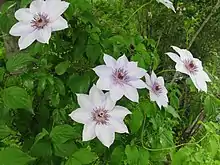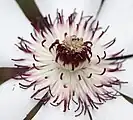| Clematis patens | |
|---|---|
 | |
| Scientific classification | |
| Kingdom: | Plantae |
| Clade: | Tracheophytes |
| Clade: | Angiosperms |
| Clade: | Eudicots |
| Order: | Ranunculales |
| Family: | Ranunculaceae |
| Genus: | Clematis |
| Species: | C. patens |
| Binomial name | |
| Clematis patens | |
| Synonyms[3] | |
| |
Clematis patens is a species of perennial plant in the genus Clematis in the Ranunculaceae family. It is native to Japan (Honshu, Shikoku, and northern Kyushu) and Northeast Asia. It usually grows on the edge of forests. It is also planted for ornamental purposes.[4]
Etymology
The name of the genus Clematis is a derivation of the Ancient Greek word "clématis", which means "climbing". This is a description of the tendency that species show to be climbers.[5] And patens means "opening". In Japan, C. patens is called "kazaguruma", which means pinwheel.[6]
Description
Stem
The stems are brown and they become woody.[7]
Flower
White or pale purple single flowers grow at the tips of short shoots in May or June. The calyx that looks like a petal is usually 8 pieces and length of 7–8 cm, but the variation is large depending on the type. Achene is broad-ovate, yellow-brown feather-like.[7]
Leaf
The leaves are pinnate compound leaves consisting of 3–5 leaflets and length of 3–10 cm.[7]


 The young achene
The young achene
Conservation
C. patens has been designated as Near Threatened (NT) on the Red List by the Ministry of the Environment in Japan,[1] and some prefectures in Japan have been designated as Red List.[8]
Cultural significance
"The native fabric of Clematis patens" in Uda, Nara was designated as a Japanese national natural monument on 14 January 1948.[9][10] C. patens has been designated as a city flower in Funabashi, Chiba.[11]
References
- 1 2 "RL/RDB". Ministry of the Environment (Japan). Retrieved 5 June 2021.
- ↑ Kohji Yonekura, Tadashi Kajita (2003). "カザグルマ". YList. Retrieved 5 June 2021.
- ↑ "Clematis patens". Global Biodiversity Information Facility. Retrieved 13 June 2021.
- ↑ "カザグルマ(クレマチス)". NTT Resonant Inc. Retrieved 7 June 2021.
- ↑ "「クレマチス」の意味・由来・語源". Lookvise, Inc. 8 April 2010. Retrieved 5 June 2021.
- ↑ "「カザグルマ」の意味・由来・語源". Lookvise, Inc. 8 April 2010. Retrieved 6 June 2021.
- 1 2 3 日本の野草(Japanese wildflowers, ISBN 978-4-635-09042-1) Page 473
- ↑ "日本のレッドデータ検索システム". EnVision. 5 January 2021. Retrieved 5 June 2021.
- ↑ "国指定文化財等データベース「カザグルマ自生地」". Agency for Cultural Affairs. 14 October 1948. Retrieved 5 June 2021.
- ↑ "国指定文化財". Uda, Nara. 1 September 2016. Retrieved 5 June 2021.
- ↑ "市の木・市の花". Funabashi. 7 April 2020. Retrieved 5 June 2021.